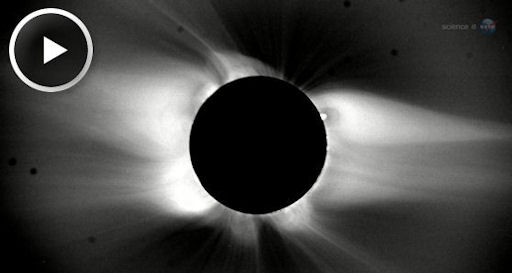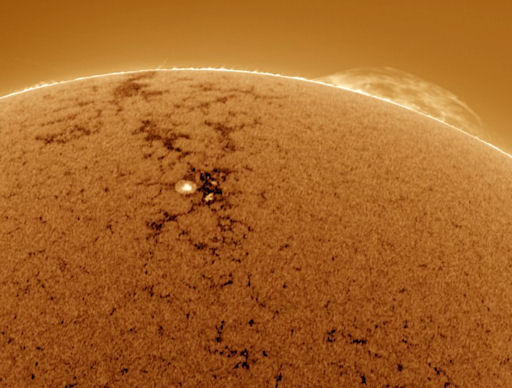CME IMPACT: An interplanetary shock wave (probably the leading edge of a CME) hit Earth's magnetic field on Nov. 12th at approximately 2300 UT. NOAA forecasters estimate a 55% chance of polar geomagnetic storms in response to the impact. High-latitude sky watchers are already seeing Northern Lights around the Arctic Circle. Aurora alerts: text, voice.
TOTAL ECLIPSE OF THE SUN: The staff of spaceweather.com are in Australia this week to witness a total eclipse of the sun on Nov. 13/14. The path of totality cuts right across Port Douglas and Cairns, Qld--a.k.a. the "Gateway to the Great Barrier Reef." People on cruise ships, divers in the reef, and thousands of people standing along beaches of the Coral Sea will witness the early morning sun disappear behind the Moon for more than two minutes. It's going to look something like this:
The only cloud on the horizon is ... well ... clouds. Residents are hoping that the gray skies they have been seeing in recent mornings will turn blue before the big moment arrives. Totality begins on Wednesday, Nov. 14th, at 06:38 am local time in northeast Australia (the afternoon of Nov. 13th in the USA) with the rising sun just 14 degrees above the horizon.
Spaceweather.com author Dr. Tony Phillips will be running the Solar Eclipse Marathon, which begins at 3rd contact when the first ray of sunlight lances over the limb of the retreating Moon. Race organizers say its "the first marathon with an intergalactic starting gun." Actually, it's the first marathon with a rubber chicken. Phillips' running mate in the race will be the fowl Camilla, who is incorporating the 26 mile run into her astronaut training.
Stay tuned for photos and updates from the path of totality.
Realtime Space Weather Photo Gallery
EASTERN ACTIVITY: A phalanx of sunspots is rotating over the sun's eastern limb, and this could bring an uptick in solar activity. "Today the sun looks alive again with lots of sunspots and magnetic filaments rising over the sun's eastern edge," reports amateur astronomer Sergio Castillo, who sends this picture from Inglewood, California:
Castillo took the picture using a solar telescope capped with a Ca K filter tuned to the light of singly-ionized calcium. Ca K ("calcium K") filters are particularly good at revealing the magnetic froth around active sunspots; pictured above is sunspot complex 1614-1615.
"These active regions look great," says Castillo, "but nothing is going to be more amazing than tomorrow's total solar eclipse that is going to be visible in Australia. I expect to see amazing images from astronomers in that location."

![]()
Solar wind
speed: 438.0 km/sec
density: 5.2 protons/cm3
explanation | more data
Updated: Today at 0114 UT
![]()
X-ray Solar Flares
6-hr max: M2 2328 UT Nov12
24-hr: M2 2328 UT Nov12
explanation | more data
Updated: Today at: 2359 UT
![]()
![]()
![]()
Daily Sun: 12 Nov 12
![]()
![]()
Sunspots 1613 and 1614 are crackling with C-class solar flares. Credit: SDO/HMI
![]()
![]()
![]()
Sunspot number: 106
What is the sunspot number?
Updated 12 Nov 2012
Spotless Days
Current Stretch: 0 days
2012 total: 0 days (0%)
2011 total: 2 days (<1%)
2010 total: 51 days (14%)
2009 total: 260 days (71%)
Since 2004: 821 days
Typical Solar Min: 486 days
Update 12 Nov 2012
The Radio Sun
10.7 cm flux: 133 sfu
explanation | more data
Updated 12 Nov 2012
![]()
![]()
![]()
Current Auroral Oval:
![]()
Switch to: Europe, USA, New Zealand, Antarctica
Credit: NOAA/POES
![]()
![]()
![]()
Planetary K-index
Now: Kp= 3 quiet
24-hr max: Kp= 3 quiet
explanation | more data
![]()
Interplanetary Mag. Field
Btotal: 21.6 nT
Bz: 1.7 nT south
explanation | more data
Updated: Today at 0116 UT
![]()
![]()
![]()
Coronal Holes: 12 Nov 12
![]()
![]()
There are no large coronal holes on the Earthside of the sun. Credit: SDO/AIA.






